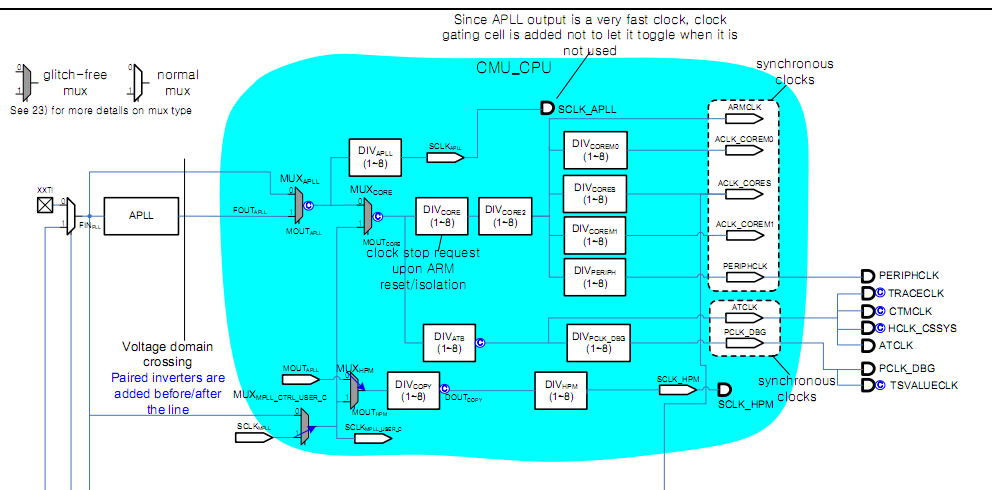理解时钟的概念可以先看看基本的模电/数电的书,<<从零开始学数字电子技术>>,
数字电路以时钟脉冲驱动,简单的情况就是一个时钟周期传1个字节数据, 时钟就是cpu的动力,没有时钟cpu就无法运行。
看一下4412的时钟流程图,

里面涉及3个概念:
MUX:多路复用,即从多个输入源中选择一个
PLL:把低频率的输入时钟提高后输出
DIV:分频器,把高频率的输入时钟降频后输出
tiny4412外接24M晶振叫做FINPLL,经过APLL提高后叫做FOUTAPLL,然后在通过MUX的选择,经DIV降成不同
的频率给其他模块用
我们通过实验把CPU频率设置成24MHz和1.4GHz, 看led闪烁会不会变慢和变快。怎么设置cpu频率呢? 当然就是配寄存器。
CPU 的工作频率为ARMCLK,计算公式如下:
ARMCLK = MUXCORE的输出 / DIVCORE / DIVCORE2
= MOUTCORE / (CORE_RATIO + 1) / DIVCORE2
= MOUTCORE / (CORE_RATIO + 1) / (CORE2_RATIO + 1)
MOUTCORE表示MUXCORE的输出,在MUXAPLL为1、MUXCORE为0时,它等于“MDIV x FIN / (PDIV x 2 ^ SDIV),即APLL的输出FOUT”
ARMCLK的通路如下,我们就配置这条通路需要的寄存器:

//led.c文件
#define GPM4CON (*(volatile unsigned int *)0x110002E0)
#define GPM4DAT (*(volatile unsigned int *)0x110002E4)
// CMU_CPU
#define CLK_SRC_CPU (*(volatile unsigned int *)0x10044200)
#define CLK_DIV_CPU0 (*(volatile unsigned int *)0x10044500)
#define CLK_DIV_CPU1 (*(volatile unsigned int *)0x10044504)
// CMU_DMC
#define CLK_SRC_DMC (*(volatile unsigned int *)0x10040200)
#define CLK_DIV_DMC0 (*(volatile unsigned int *)0x10040500)
#define CLK_DIV_DMC1 (*(volatile unsigned int *)0x10040504)
// CMU_TOP
#define CLK_SRC_TOP0 (*(volatile unsigned int *)0x1003C210)
#define CLK_SRC_TOP1 (*(volatile unsigned int *)0x1003C214)
#define CLK_DIV_TOP (*(volatile unsigned int *)0x1003C510)
// CMU_LEFTBUS
#define CLK_SRC_LEFTBUS (*(volatile unsigned int *)0x10034200)
#define CLK_DIV_LEFTBUS (*(volatile unsigned int *)0x10034500)
// CMU_RIGHTBUS
#define CLK_SRC_RIGHTBUS (*(volatile unsigned int *)0x10038200)
#define CLK_DIV_RIGHTBUS (*(volatile unsigned int *)0x10038500)
// locktime
#define APLL_LOCK (*(volatile unsigned int *)0x10044000)
#define MPLL_LOCK (*(volatile unsigned int *)0x10044008)
#define EPLL_LOCK (*(volatile unsigned int *)0x1003C010)
#define VPLL_LOCK (*(volatile unsigned int *)0x1003C020)
// APLL
#define APLL_CON1 (*(volatile unsigned int *)0x10044104)
#define APLL_CON0 (*(volatile unsigned int *)0x10044100)
// MPLL
#define MPLL_CON0 (*(volatile unsigned int *)0x10040108)
#define MPLL_CON1 (*(volatile unsigned int *)0x1004010c)
// EPLL
#define EPLL_CON2 (*(volatile unsigned int *)0x1003C118)
#define EPLL_CON1 (*(volatile unsigned int *)0x1003C114)
#define EPLL_CON0 (*(volatile unsigned int *)0x1003C110)
// VPLL
#define VPLL_CON0 (*(volatile unsigned int *)0x1003C120)
#define VPLL_CON1 (*(volatile unsigned int *)0x1003C124)
#define VPLL_CON2 (*(volatile unsigned int *)0x1003C128)
void clock_common_cfg(void)
{
CLK_SRC_CPU = 0x01000001;
CLK_DIV_DMC0 = 0x00111713;
CLK_DIV_DMC1 = 0x01011171;
CLK_SRC_TOP0 = 0x01110000;
CLK_SRC_TOP1 = 0x00001000;
CLK_DIV_TOP = 0x00015470;
CLK_SRC_LEFTBUS = 0x00000001;
CLK_DIV_LEFTBUS = 0x00000013;
CLK_SRC_RIGHTBUS = 0x00000001;
CLK_DIV_RIGHTBUS = 0x00000013;
APLL_LOCK = 0x00000960;
MPLL_LOCK = 0x00000000;
EPLL_LOCK = 0x00000FFF;
VPLL_LOCK = 0x00000FFF;
CLK_DIV_CPU0 = 0x00773730;
CLK_DIV_CPU1 = 0x00000077;
APLL_CON1 = 0x00003800;
APLL_CON0 = 0xA0640301;
MPLL_CON1 = 0x00003800;
MPLL_CON0 = 0xA0640301;
EPLL_CON2 = 0x00000080;
EPLL_CON1 = 0x66010000;
EPLL_CON0 = 0x00600302;
VPLL_CON2 = 0x00000080;
VPLL_CON1 = 0x66016000;
VPLL_CON0 = 0x006F0302;
CLK_SRC_CPU = 0x01000001;
CLK_SRC_DMC = 0x00111000;
CLK_SRC_TOP0 = 0x01110000;
CLK_SRC_TOP1 = 0x00001000;
}
void system_clock_14G_init(void)
{
/*
* 1. 在设置APLL之前, 先设置时钟源为晶振
*/
CLK_SRC_CPU = 0x0; //MUXAPLL选FINPLL,MUXCORE选MOUTAPLL
APLL_LOCK = 270 * 3; //设置锁定时间: APLL_CON0中PDIV=3, 所以APLL_LOCK = 270x3 */
CLK_SRC_CPU = 0x0; //MUXAPLL选FINPLL,MUXCORE选MOUTAPLL
CLK_DIV_CPU0 = 0x00773730; // CORE_RATIO,CORE2_RATIO配0
APLL_CON1 = 0x00803800; //默认
/*
* 设置APLL的M,P,S值, APLL输出 = 0xAF x 24MHz / (3 x 2 ^ 0) = 1.4GHz
* 使能APLL
*/
APLL_CON0 = (1<<31 | 0xAF<<16 | 3<<8 | 0x0);
/* 3. 设置MUX, 使用APLL的输出 */
CLK_SRC_CPU = 0x01000001;
}
void system_clock_24M_init(void)
{
CLK_SRC_CPU = 0x0; //MUXAPLL选FINPLL,MUXCORE选MOUTAPLL
CLK_DIV_CPU0 = 0x00773730; // CORE_RATIO,CORE2_RATIO配0
}
void delay(volatile int time)
{
for(; time > 0; time-- )
;
}
int main(void)
{
unsigned long tmp = 0;
//system_clock_24M_init(); //24M打开这句
system_clock_14G_init(); //1.4G打开这句
/*
* set GPM4_0 as output
*/
tmp = GPM4CON;
tmp &= ~0xffff;
tmp |= 0x1111;
GPM4CON = tmp;
while(1){
/* GPM4_0 output low */
GPM4DAT &= ~0xf;
delay(9999999);
GPM4DAT |= 0xf;
delay(9999999);
}
return 0;
}
代码位置:https://github.com/cyj1988jyc/luoji4412
数字电路以时钟脉冲驱动,简单的情况就是一个时钟周期传1个字节数据, 时钟就是cpu的动力,没有时钟cpu就无法运行。
看一下4412的时钟流程图,

里面涉及3个概念:
MUX:多路复用,即从多个输入源中选择一个
PLL:把低频率的输入时钟提高后输出
DIV:分频器,把高频率的输入时钟降频后输出
tiny4412外接24M晶振叫做FINPLL,经过APLL提高后叫做FOUTAPLL,然后在通过MUX的选择,经DIV降成不同
的频率给其他模块用
我们通过实验把CPU频率设置成24MHz和1.4GHz, 看led闪烁会不会变慢和变快。怎么设置cpu频率呢? 当然就是配寄存器。
CPU 的工作频率为ARMCLK,计算公式如下:
ARMCLK = MUXCORE的输出 / DIVCORE / DIVCORE2
= MOUTCORE / (CORE_RATIO + 1) / DIVCORE2
= MOUTCORE / (CORE_RATIO + 1) / (CORE2_RATIO + 1)
MOUTCORE表示MUXCORE的输出,在MUXAPLL为1、MUXCORE为0时,它等于“MDIV x FIN / (PDIV x 2 ^ SDIV),即APLL的输出FOUT”
ARMCLK的通路如下,我们就配置这条通路需要的寄存器:

//led.c文件
#define GPM4CON (*(volatile unsigned int *)0x110002E0)
#define GPM4DAT (*(volatile unsigned int *)0x110002E4)
// CMU_CPU
#define CLK_SRC_CPU (*(volatile unsigned int *)0x10044200)
#define CLK_DIV_CPU0 (*(volatile unsigned int *)0x10044500)
#define CLK_DIV_CPU1 (*(volatile unsigned int *)0x10044504)
// CMU_DMC
#define CLK_SRC_DMC (*(volatile unsigned int *)0x10040200)
#define CLK_DIV_DMC0 (*(volatile unsigned int *)0x10040500)
#define CLK_DIV_DMC1 (*(volatile unsigned int *)0x10040504)
// CMU_TOP
#define CLK_SRC_TOP0 (*(volatile unsigned int *)0x1003C210)
#define CLK_SRC_TOP1 (*(volatile unsigned int *)0x1003C214)
#define CLK_DIV_TOP (*(volatile unsigned int *)0x1003C510)
// CMU_LEFTBUS
#define CLK_SRC_LEFTBUS (*(volatile unsigned int *)0x10034200)
#define CLK_DIV_LEFTBUS (*(volatile unsigned int *)0x10034500)
// CMU_RIGHTBUS
#define CLK_SRC_RIGHTBUS (*(volatile unsigned int *)0x10038200)
#define CLK_DIV_RIGHTBUS (*(volatile unsigned int *)0x10038500)
// locktime
#define APLL_LOCK (*(volatile unsigned int *)0x10044000)
#define MPLL_LOCK (*(volatile unsigned int *)0x10044008)
#define EPLL_LOCK (*(volatile unsigned int *)0x1003C010)
#define VPLL_LOCK (*(volatile unsigned int *)0x1003C020)
// APLL
#define APLL_CON1 (*(volatile unsigned int *)0x10044104)
#define APLL_CON0 (*(volatile unsigned int *)0x10044100)
// MPLL
#define MPLL_CON0 (*(volatile unsigned int *)0x10040108)
#define MPLL_CON1 (*(volatile unsigned int *)0x1004010c)
// EPLL
#define EPLL_CON2 (*(volatile unsigned int *)0x1003C118)
#define EPLL_CON1 (*(volatile unsigned int *)0x1003C114)
#define EPLL_CON0 (*(volatile unsigned int *)0x1003C110)
// VPLL
#define VPLL_CON0 (*(volatile unsigned int *)0x1003C120)
#define VPLL_CON1 (*(volatile unsigned int *)0x1003C124)
#define VPLL_CON2 (*(volatile unsigned int *)0x1003C128)
void clock_common_cfg(void)
{
CLK_SRC_CPU = 0x01000001;
CLK_DIV_DMC0 = 0x00111713;
CLK_DIV_DMC1 = 0x01011171;
CLK_SRC_TOP0 = 0x01110000;
CLK_SRC_TOP1 = 0x00001000;
CLK_DIV_TOP = 0x00015470;
CLK_SRC_LEFTBUS = 0x00000001;
CLK_DIV_LEFTBUS = 0x00000013;
CLK_SRC_RIGHTBUS = 0x00000001;
CLK_DIV_RIGHTBUS = 0x00000013;
APLL_LOCK = 0x00000960;
MPLL_LOCK = 0x00000000;
EPLL_LOCK = 0x00000FFF;
VPLL_LOCK = 0x00000FFF;
CLK_DIV_CPU0 = 0x00773730;
CLK_DIV_CPU1 = 0x00000077;
APLL_CON1 = 0x00003800;
APLL_CON0 = 0xA0640301;
MPLL_CON1 = 0x00003800;
MPLL_CON0 = 0xA0640301;
EPLL_CON2 = 0x00000080;
EPLL_CON1 = 0x66010000;
EPLL_CON0 = 0x00600302;
VPLL_CON2 = 0x00000080;
VPLL_CON1 = 0x66016000;
VPLL_CON0 = 0x006F0302;
CLK_SRC_CPU = 0x01000001;
CLK_SRC_DMC = 0x00111000;
CLK_SRC_TOP0 = 0x01110000;
CLK_SRC_TOP1 = 0x00001000;
}
void system_clock_14G_init(void)
{
/*
* 1. 在设置APLL之前, 先设置时钟源为晶振
*/
CLK_SRC_CPU = 0x0; //MUXAPLL选FINPLL,MUXCORE选MOUTAPLL
APLL_LOCK = 270 * 3; //设置锁定时间: APLL_CON0中PDIV=3, 所以APLL_LOCK = 270x3 */
CLK_SRC_CPU = 0x0; //MUXAPLL选FINPLL,MUXCORE选MOUTAPLL
CLK_DIV_CPU0 = 0x00773730; // CORE_RATIO,CORE2_RATIO配0
APLL_CON1 = 0x00803800; //默认
/*
* 设置APLL的M,P,S值, APLL输出 = 0xAF x 24MHz / (3 x 2 ^ 0) = 1.4GHz
* 使能APLL
*/
APLL_CON0 = (1<<31 | 0xAF<<16 | 3<<8 | 0x0);
/* 3. 设置MUX, 使用APLL的输出 */
CLK_SRC_CPU = 0x01000001;
}
void system_clock_24M_init(void)
{
CLK_SRC_CPU = 0x0; //MUXAPLL选FINPLL,MUXCORE选MOUTAPLL
CLK_DIV_CPU0 = 0x00773730; // CORE_RATIO,CORE2_RATIO配0
}
void delay(volatile int time)
{
for(; time > 0; time-- )
;
}
int main(void)
{
unsigned long tmp = 0;
//system_clock_24M_init(); //24M打开这句
system_clock_14G_init(); //1.4G打开这句
/*
* set GPM4_0 as output
*/
tmp = GPM4CON;
tmp &= ~0xffff;
tmp |= 0x1111;
GPM4CON = tmp;
while(1){
/* GPM4_0 output low */
GPM4DAT &= ~0xf;
delay(9999999);
GPM4DAT |= 0xf;
delay(9999999);
}
return 0;
}
代码位置:https://github.com/cyj1988jyc/luoji4412